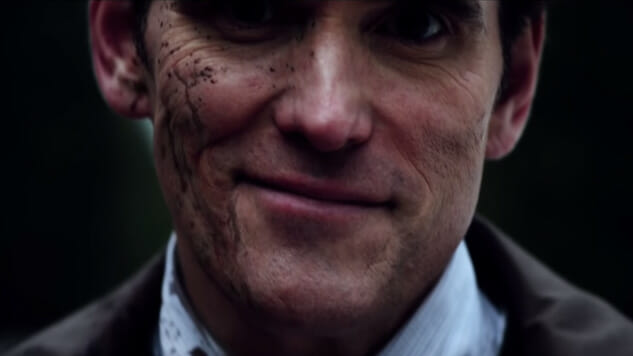Queer Eye for the Straight Director
Lars von Trier uses the bodies of (suffering) women to explore a deeper understanding of his identity? Sounds like a queer man to me.

Amongst the bushel of conclusions one can draw after sitting through the newest film by Danish director Lars von Trier, the most pertinent, perhaps pressing, is: Lars, I think you need some therapy. On the one hand, The House That Jack Built is a cheeky, nasty piece of a confession about the agony of artistry and mental illness, about representation in art as its own form of murder. On the other, it’s a smirking, smarting portrait of an art house bad boy pontificating, getting close to breakthrough, but too caught up in the spectacle of words and rhetoric to ever breach something with total sincerity—like a patient in a therapist’s office who knows they can get off the hook by talking a lot. It’s a spiritual successor to von Trier’s “Depression Trilogy” (Antichrist, Melancholia and Nymphomaniac), but more directly a continuation of the self-reflexivity and self-effacement of Nymphomaniac, both in style and emotional content.
And it’s…fine? The House That Jack Built is von Trier’s first film to have a man as a protagonist in over a decade (the last time was in 2006’s office comedy—yes—The Boss of It All), a factor he is both blindingly aware of and yet totally oblivious to.
Jack’s (Matt Dillon) quest for artistic perfection by way of a perfect house and more perfect murders is plagued by anxiety, neurosis and OCD, which is, by no means, to be discounted. And while Dillon does a commendable job as Patrick Bateman’s somewhat more pretentious older brother (his debate between he and unseen Virgil about art, ethics, pain, pleasure, love and hate is surely entertaining), there is, at least for me, something missing in Jack—or, once evolved as a serial killer, Mr. Sophistication—besides his rhetorical backtracking. Maybe this is the most heterosexual film Lars von Trier has made in decades?
While von Trier came out of the gate intending to ruffle the feathers of critics and audiences back with his pre-Dogme sci-fi/dystopia/murder mystery experiment The Element of Crime (1984), he’s undoubtedly most famous, and has gathered the most polarizing responses, for his films about women. From Breaking the Waves (which garnered star Emily Watson an Academy Award nomination) to Dancer in the Dark (and one for Bjork), to Dogville and Antichrist, to Melancholia, his female characters are, depending on whom you ask, subject to deep misogyny—to an “unrelenting assault on the female body” or capable of “show[ing] an immense spectrum of strength, perseverance, and cunning, trumping a large majority of the fluffy, feeble female characterizations shown in modern cinema.” He has said, in so many words, that he identifies with his female characters, and, regarding what Antichrist’s Charlotte Gainsbourg told the Guardian, “I find it unjust when people say he hates women. I really have the impression that I was playing him, that he was the woman, that he was going through that misery, the physical condition, the panic attacks.”
Yes, the women in his films face an excruciating, ungodly amount of spiritual, emotional and physical pain. Abuse, rape, misfortune, entrapment, social marginalization. But also, yes, they are more often than not upheld by the end, vindicated, transcending the material and physical world around them. An artist using the body of a (suffering) woman to explore a deeper understanding of their identity and a sense of otherness or angst in the world? Sounds like a queer man to me.
My friend Reid Rohling quipped, “Straight men love LVT cause they [love living] vicariously through men killing women.” Which I don’t think is untrue. But I also believe that, maybe a little paradoxically, the queer appeal in Lars von Trier’s work exists, too, in identifying with the very women who are suffering, whose concepts of pain and pleasure, borne out of being socialized within an equally cruel world, are hazy and opaque. In essence, Lars von Trier has a straight man’s eye for sadism and a queer man’s nerve for masochism, creating an inherent duality to his art and representation.
The director has said he once wished to be a gay man. Von Trier, while rarely written about in this context outside of academia, has a bit of a melodramatist in him. He presents a quasi-nuclear familial structure or romantic dynamic and then breaks it—as a rejection of the genre—never to be pieced back together. He’s a more cynical, yet no less romantic, Douglas Sirk: He lives in a high emotional state, operating with an operatic sense of feeling reminiscent of the romantics. He begins Melancholia with Wagner’s “Tristan and Isolde” prelude. Breaking the Waves was literally adapted as an opera with music by Missy Mazzoli and a libretto by Royce Vavrek.
-

-

-

-

-

-

-

-

-

-

-

-

-

-

-

-

-

-

-

-

-

-

-

-

-

-

-

-

-

-

-

-

-

-

-

-

-

-

-

-








































